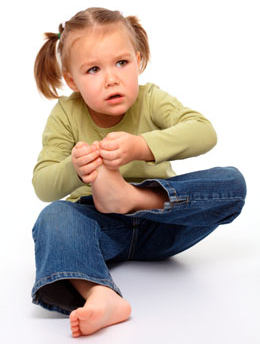Heel pain could be caused due to a wide range of reasons. It could also affect children. The following article provides information on the causes, symptoms, and treatment for this foot problem.

In case of children, heel pain could be caused due to medical conditions such as
Sever disease. Usually, young children in the age group of 10 to 14 years, might get affected by this pain. Boys are more frequently affected by this pain than girls. The pain is felt at the back of the heel, and sometimes, at the bottom of the heel as well. It may not be constant, and might range from mild to severe. It can affect one or both legs.
Causes and Symptoms
This starts due to overuse of heels, involving physical activities like running and jumping. Sever disease occurs, when there is some temporary distortion in the Achilles tendon. Tendon is a soft tissue, by which, muscles attaches to bone. Achilles is one of the longest tendons in the body. It attaches the calf muscle to the back of the heel bone. Sever disease occurs when the growth of the calf bones, calf muscles, and Achilles tendon is not properly matched. In other words, the growth of the bones is faster as compared to the growth of the muscles and the tendon. As a result, the muscle and the tendon tends to become taut and gives rise to pain. It's usually found in athletes, due to running or jumping on hard surfaces. Excessive physical activity, use of ill-fitting shoes, injury to bones/muscles of the feet or ankle area, can increase the intensity of the pain.
Other causes include:
- Plantar fasciitis
- Inflammation in the ligament lying between heel bone and sole of the foot
- Achilles tendonitis
- Stress fractures caused due to hard impact on the heel bone
- Bursitis
The pain is felt in the area surrounding the Achilles tendon. In the initial stage, the child will complain of pain, after performing some physical exercise. However, he/she is likely to feel better after taking some rest. Later, swelling might worsen, which in turn, may cause the child to become so sensitive that he/she might not even let the parents touch that area. Stiffness in the calf muscles might be felt particularly after getting down from the bed. The child might even limp while walking due to the pain. Some children might even develop the habit of tiptoeing.
Treatment
If a child has been experiencing pain in the heel quite frequently, then it would be best to consult a physiotherapist for proper diagnosis of the problem. The underlying cause can be identified with the help of a physical examination and X-ray examination of the foot. Depending on the examination, the physiotherapist will ascertain the activities permissible for the child, and also the amount of rest required. In case the pain is unbearable, painkillers are prescribed. If the mobility of the leg gets affected or fracture has been detected, then splinting or casting may be done. In this case, complete rest is advised. At home, whenever the child complains of pain, ice packs can be applied for 10 - 15 minutes. This would provide some relief from the pain. Doctors suggest that the temporary use of shoe inserts can have a traction effect on the tendon, and help in soothing the pain. Physiotherapy and stretching exercises are also beneficial in pain management.
Heel pain in children is not something to be worried about. There is no evidence which suggests that it has caused any kind of complication in the long run. Once the pain is cured, your child can resume normal sports activities all over again.
Disclaimer:
This Buzzle article is for informative purposes only, and should not be used as a replacement for expert medical advice.


 In case of children, heel pain could be caused due to medical conditions such as Sever disease. Usually, young children in the age group of 10 to 14 years, might get affected by this pain. Boys are more frequently affected by this pain than girls. The pain is felt at the back of the heel, and sometimes, at the bottom of the heel as well. It may not be constant, and might range from mild to severe. It can affect one or both legs.
In case of children, heel pain could be caused due to medical conditions such as Sever disease. Usually, young children in the age group of 10 to 14 years, might get affected by this pain. Boys are more frequently affected by this pain than girls. The pain is felt at the back of the heel, and sometimes, at the bottom of the heel as well. It may not be constant, and might range from mild to severe. It can affect one or both legs.